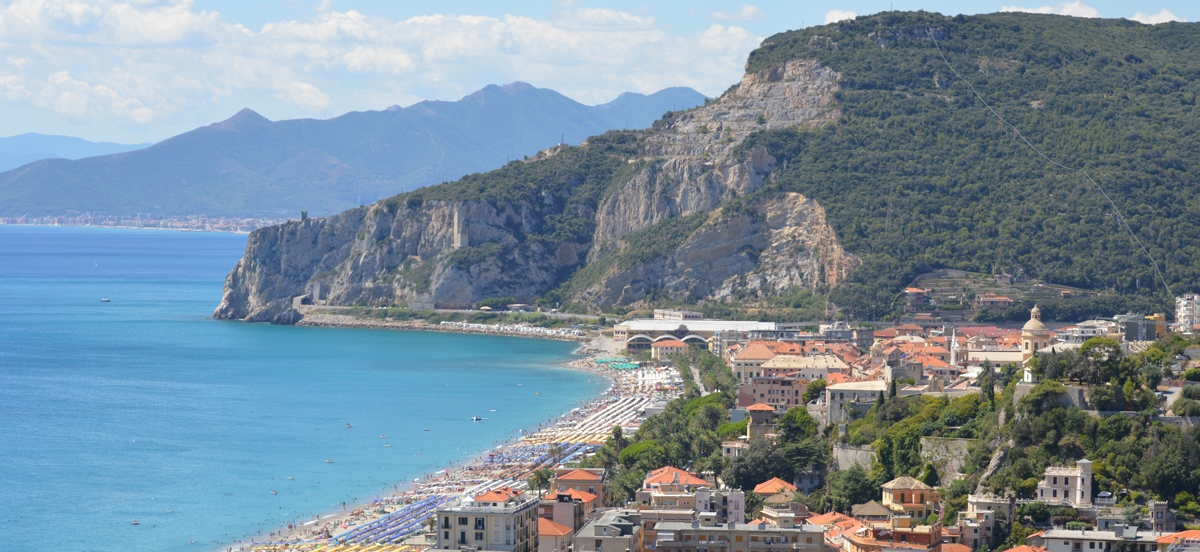From “Ripa Maris” to Marina del Finale

Finalmarina
The current-day town of Finalmarina is the result of two thousand years of complex historical events.
Proof of the existence of a first settlement in the natural inlet by the mouth of the Pora Creek dates back to after the Roman conquest of Western Liguria in 181 BCE.
The first Roman Republican settlement grew over the following centuries up until the 5th century, when a baptistry church was built in the neighbouring area which later became the medieval “Parish Church of Finale” or Pieve del Finale. A number of Roman and Byzantine coins have been found in the area which Finalese historian Giovanni Andrea Silla called “the foot of the Gòttero” – an open reference to the mountainous promontory separating Marina del Finale from the Finalpia Valley.
In the 12th century, the beach of the Marina was used to build ships that would sail the Mediterranean routes.
The marquises Del Carretto’s choice to found the signorile [t.n.: signoria is an abstract noun meaning (roughly) government; governing authority] Town of Finale on the spot where the Pora and Aquila creeks meet, and the construction of Castelfranco sul Gòttero by the Genoese in 1365 clearly influenced the development of Finale seashore, commonly called Ripa maris.
Orders by Giacomo Del Carretto in 1258 and Law Statutes of Finale dated 1312 forbade the construction of new houses on the Marina, as well as its inhabitation by barbers or craftsmen, and well as any retail trade. De facto, urban planning of the Marina only began between the second half of the 15th and 16th centuries.
As of 1450, we know that a large open esplanade-cum-town-square called “platea magna” lay at the very heart of the settlement. Nowadays, this area is taken up by Piazza Vittorio Emanuele II Square. Trading took place in this area and between the 16th and 17th centuries a long covered porticoed loggia was built at the far end of the thoroughfare, so that the town spread out along its two sides into two rows of houses along the beachfront.
In 1562, worship moved from the old Pieve del Finale to the church of Saint Antonio in the Marina, as the old parish church was too far from the newly developing town. Behind the platea magna construction began in 1619 of the inordinately expensive new Basilica of Saint Giovanni, which was only completed in 1674.
A grand triumphal arch was erected in honour of the landing of Infanta Margarita of Spain in August 1666. To this day, the archway is one of the landmarks of Finale.
During the Spanish period and through the Genoese domination, which began in 1713, a number of prominent local families moved into the Marina. Among them were the Buraggi, Locella, De Raimondi, Ferri and Malvasia Families, who built their grand mansion-houses-cum-palaces in this area.
Final recognition was given to the Marina as being the epicentre of the entire area in 1927, when the town hall of the new municipality of Finale Ligure was established after the pre-existing municipalities of Marina, Borgo, Pia and Varigotti were forcedly merged into one.
Seaside tourism developed during the 20th century, leading to further urban development as well as the cancellation of the ancient landscapes of pre-existing coastal settlements.
HOW TO REACH
![]() Finalmarina
Finalmarina
How to reach the site
Finalmarina can be reached from the A10 motorway junctions of Feglino (for those coming from Genoa, Turin or Milan) and Finale Ligure (from all directions), or by taking SS 1 Via Aurelia State Road. Alternatively, if travelling by train, disembark at Finale Ligure.
Visit
Feel free to use fact sheets and website of the Museo Archeologico del Finale to tour the town and its monuments.
Info
GALLERY
[ls_content_block id=”7170″]



